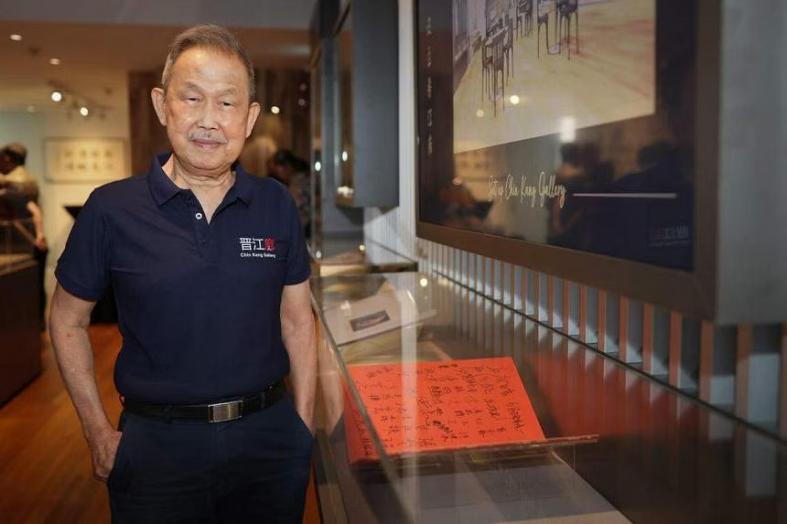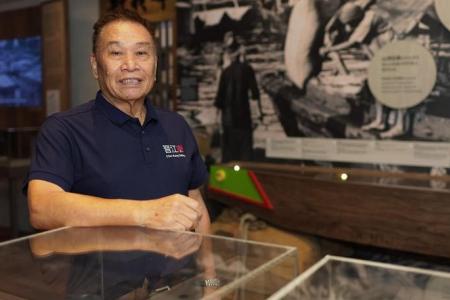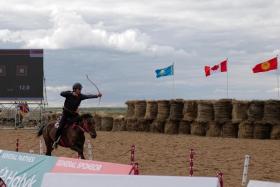‘So tiring I could fall asleep standing’: Ex-coolie recalls tough times at launch of heritage gallery
Mr Ong Wee Serm remembers the years toiling as a coolie, or manual labourer who moved goods to and from ships off the coast of Singapore.
The 77-year-old, who was a coolie for a decade from 1963, unloaded items like rice, corn and beans from ships onto “twakows” or bumboats docked next to the vessels. Each sack weighed about 100.8kg, a load which he had to shoulder repeatedly for at least eight hours a day.
“It was so tiring I could fall asleep standing,” he told The Straits Times at the launch of a gallery which documents, among other things, the contributions of such workers. “I could continue to sleep even when the rain fell on me.”
However, the constant worry for Mr Ong – who was in his late teens to 20s then – was not the physical exhaustion, but if there was work the next day. He always volunteered for overtime duties, even if it meant slogging non-stop for 24 hours on some days.
“I asked for work even on Chinese New Year, when we would get more pay,” he said. “I just wanted to make ends meet.”
While meals were provided during his shift, he would fill his stomach with a simple breakfast before his shift started at around 7.30am – whether it was plain porridge at 10 cents or white rice at 20 cents per bowl. Occasionally, he would pay 10 cents more for some preserved vegetables.
Today, Mr Ong is managing director of a wholesale business in dried foods like mushrooms and beans, which he set up after years of hardship and savings. He lives in a private property in Katong with his wife and three children.
On Thursday, he attended the roll-out of the heritage gallery that pays tribute to the pioneering contributions of coolies to Singapore’s early development and nation-building. He contributed several artefacts such as a double hook used to drag gunny sacks of goods.
The Chin Kang Gallery is set up by the Singapore Chin Kang Huay Kuan, which started in 1918 to support migrants from Jinjiang county in south-east Fujian, China, where Mr Ong came from at age 11.
The gallery, on the fourth floor of the clan association’s building in Bukit Pasoh Road, spans an area of 270 sq m. Constructed at a cost of $500,000, it received funding support from the National Heritage Board and the association’s members, which total more than 1,200.
There are eight thematic exhibition zones covering topics including the lives and endeavours of the coolies, the clan association’s role during World War II, and the School of Chin Kang, which ceased operation at end 1975 after nurturing almost 20,000 youth for nearly 28 years. It was sited within the clan association’s premises and closed when more public schools were set up following Singapore’s independence in 1965.
Retired teacher Anthony Ho, 82, whose father also worked as a coolie, contributed some of the latter’s work tools.
“The gallery brings back many fond memories of my fun school days and the caring teachers,” said Mr Ho who studied in the School of Chin Kang from 1953 to 1957. “I invited some of my former classmates to our launch today, but unfortunately, most of them are not mobile anymore.”

Mr Edwin Tong, Minister for Culture, Community and Youth, said the setting up of the gallery is “most timely”. “While it focuses on the sharing of the stories of pioneer migrants’ journey from Jinjiang, this story would resonate very strongly with other communities,” he noted at the launch.
“It reminds us of the hardships that our pioneers went through, their spirit of unity and mutual support, as well as virtues of perseverance and resilience, qualities that made our society what it is today.”
He added that these are values that have helped Singapore overcome economic and social crises, like the Covid-19 pandemic.

He applauded the clan association for adapting its programmes to remain relevant, such as the setting up of the gallery. Besides serving its members, it also expanded its role to benefit the wider society and support nation-building.
Mr Jimmy Teo Chin Meng, president of Chin Kang Huay Kuan, said it will be inviting senior citizens and students to visit the gallery. People can also rent the space for wedding solemnisations, cultural performances and educational talks.
Starting from Oct 14, Chin Kang Gallery will be open on Tuesdays, Thursdays and Saturdays, from 10am to 3pm. Admission is free. Those interested in arranging group tours can call 6223 5913 or e-mail chinkang@singnet.com.sg.
Get The New Paper on your phone with the free TNP app. Download from the Apple App Store or Google Play Store now


